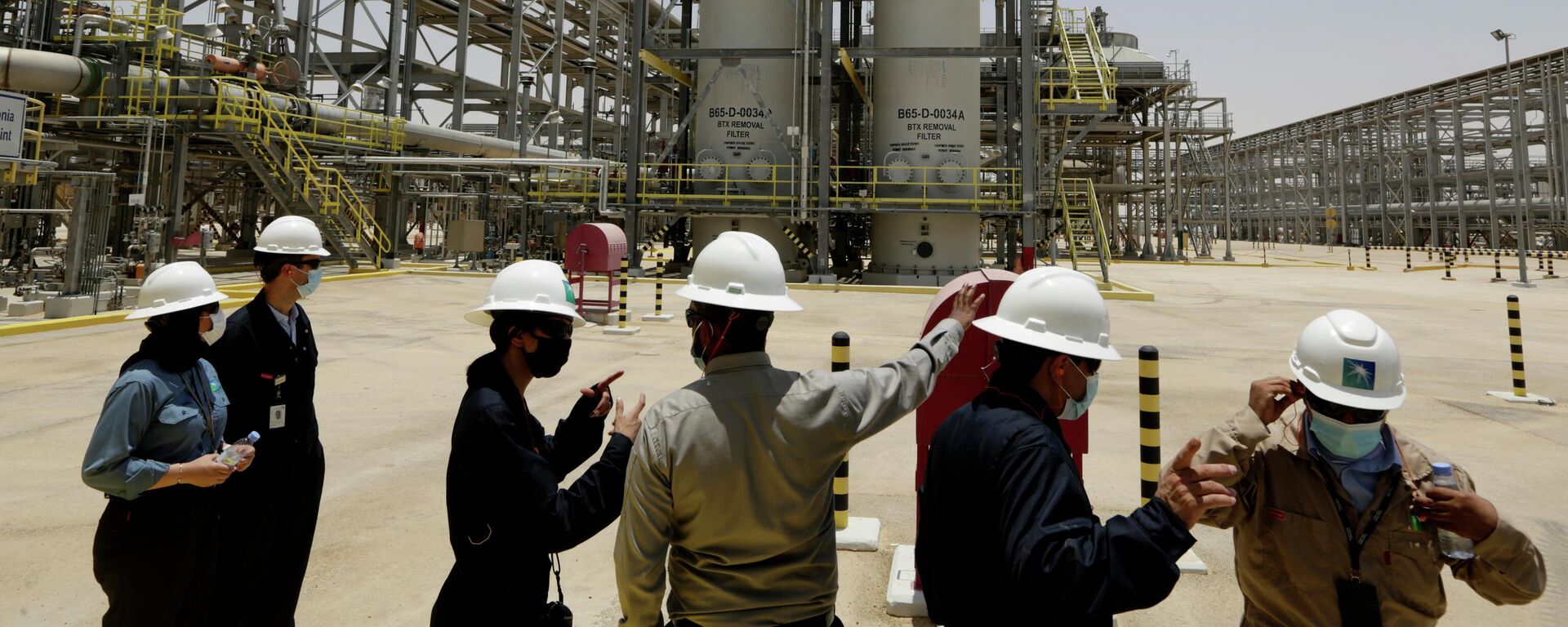https://sputnikglobe.com/20220509/oil-dives-6-as-dollar-hits-20-year-highs-on-us-rate-hike-fears-1095382949.html
Oil Dives 6% as Dollar Hits 20-Year Highs on US Rate Hike Fears
Oil Dives 6% as Dollar Hits 20-Year Highs on US Rate Hike Fears
Sputnik International
NEW YORK (Sputnik) - Crude prices tumbled 6% on Monday as the dollar soared to a 20-year high amid investor fear that the Federal Reserve will hike US interest... 09.05.2022, Sputnik International
2022-05-09T21:18+0000
2022-05-09T21:18+0000
2022-05-09T21:18+0000
us stocks
oil prices
consumer price index (cpi)
us
inflation
https://cdn1.img.sputnikglobe.com/img/07e6/05/09/1095382086_47:0:3688:2048_1920x0_80_0_0_80e3e203850acbf3d82005416b1c1786.jpg
Brent crude, the global benchmark for oil traded in London, settled down $6.45, or 5.7%, at $105.94 a barrel.New York-traded West Texas Intermediate (WTI), the benchmark for US crude, finished Monday’s trading session down $6.68, or 6.1%, at $103.09.The drop wiped out last week’s near 6% gain on both Brent and WTI after oil exporters in the OPEC+ alliance agreed at their monthly meeting to a nominal output hike of 432,000 barrels per day that fell well short of the projected summer demand for oil.The slump in crude prices came as officials at the central bank debated on whether the next US rate hike should be 75 basis points, with some saying that would be excessive while others argued it might be necessary to stop runaway inflation. The last time the Fed raised rates by 75 basis points was almost three decades ago, in 1994.Money markets traders have already priced in a 79% chance of a 75-bps hike at the Fed’s upcoming June 14-15 meeting — after last week’s 50-bps increase at its May meeting, which in itself was the largest increase in 20 years.The Fed insists that its regime of high rate hikes will not land the US economy in recession, though the markets aren’t convinced by that.Commodities aside, stocks on Wall Street also plunged, with the Nasdaq Composite index — which groups top technology names such as Facebook*, Amazon, Apple, Netflix and Google — hitting a session low of 11,646 on Monday that matched a bottom from November 2020. The Nasdaq is already down 5% for May, extending April’s 13% selloff. Year-to-date, the tech barometer has lost 25%.The price of Bitcoin, meanwhile, plunged by more than 50% from its record high, hovering at just below $31,000 in New York’s afternoon trading versus its November record high of $68,991.The dollar — the main beneficiary in any US rate hike — surged to 20-year highs, with the Dollar Index, which pits the greenback against six other major currencies, scaling 104.12, a peak since 2002.After contracting 3.5% in 2020 from disruptions forced by the coronavirus pandemic, the US economy grew by 5.7% in 2021, expanding at its quickest pace since 1982.But inflation grew even faster. The Personal Consumption Expenditure Index, a US inflation indicator closely followed by the Fed, rose by 5.8% in the year to December and 6.6% in the 12 months to March. Both readings indicated the fastest growth since the 1980s.The US Consumer Price Index, or CPI, another key measure for inflation, rose 8.5% in the year to March. The April reading for the CPI is on Wednesday, with analysts betting on a 8.1% growth year-on-year, though the actual number could be much higher.The Fed’s own tolerance for inflation is a mere 2% per year.*banned in Russia as an extremist organization
https://sputnikglobe.com/20220507/opec-wont-boost-oil-production-to-help-the-west-contain-rising-energy-prices---report-1095339424.html
Sputnik International
feedback@sputniknews.com
+74956456601
MIA „Rossiya Segodnya“
2022
Sputnik International
feedback@sputniknews.com
+74956456601
MIA „Rossiya Segodnya“
News
en_EN
Sputnik International
feedback@sputniknews.com
+74956456601
MIA „Rossiya Segodnya“
Sputnik International
feedback@sputniknews.com
+74956456601
MIA „Rossiya Segodnya“
us stocks, oil prices, consumer price index (cpi), us, inflation
us stocks, oil prices, consumer price index (cpi), us, inflation
Oil Dives 6% as Dollar Hits 20-Year Highs on US Rate Hike Fears
NEW YORK (Sputnik) - Crude prices tumbled 6% on Monday as the dollar soared to a 20-year high amid investor fear that the Federal Reserve will hike US interest rates so high that the economy will fall into a recession.
Brent crude, the global benchmark for oil traded in London, settled down $6.45, or 5.7%, at $105.94 a barrel.
New York-traded West Texas Intermediate (WTI), the benchmark for US crude, finished Monday’s trading session down $6.68, or 6.1%, at $103.09.
The drop wiped out last week’s near 6% gain on both Brent and WTI after oil exporters in the OPEC+ alliance agreed at their monthly meeting to a nominal output hike of 432,000 barrels per day that fell well short of the projected summer demand for oil.
"The Fed looks increasingly belligerent where rates are concerned and this could spook sentiment across, beginning with stocks right through to oil," John Kilduff, founding partner at New York energy hedge fund Again Capital, said.
The slump in crude prices came as officials at the central bank debated on whether the next US rate hike should be 75 basis points, with some saying that would be excessive while others argued it might be necessary to stop runaway inflation. The last time the Fed raised rates by 75 basis points was almost three decades ago, in 1994.
Money markets traders have already priced in a 79% chance of a 75-bps hike at the Fed’s upcoming June 14-15 meeting — after last week’s 50-bps increase at its May meeting, which in itself was the largest increase in 20 years.
The Fed insists that its regime of high rate hikes will not land the US economy in recession, though the markets aren’t convinced by that.
"Wall Street remains uninspired to ‘buy the dip’ as inflation seems poised to remain stubbornly high, which will force the Fed to tighten policy to levels that will jeopardize the soft landing most traders were expecting," Ed Moya, analyst at online trading platform OANDA, concurred with that view. "Oil prices are dropping fast as crude demand destruction fears grow given China’s COVID situation and the de-risking event happening with U.S. stocks."
Commodities aside, stocks on Wall Street also plunged, with the Nasdaq Composite index — which groups top technology names such as Facebook*, Amazon, Apple, Netflix and Google — hitting a session low of 11,646 on Monday that matched a bottom from November 2020. The Nasdaq is already down 5% for May, extending April’s 13% selloff. Year-to-date, the tech barometer has lost 25%.
The price of Bitcoin, meanwhile, plunged by more than 50% from its record high, hovering at just below $31,000 in New York’s afternoon trading versus its November record high of $68,991.
The dollar — the main beneficiary in any US rate hike — surged to 20-year highs, with the Dollar Index, which pits the greenback against six other major currencies, scaling 104.12, a peak since 2002.
After contracting 3.5% in 2020 from disruptions forced by the coronavirus pandemic, the US economy grew by 5.7% in 2021, expanding at its quickest pace since 1982.
But inflation grew even faster. The Personal Consumption Expenditure Index, a US inflation indicator closely followed by the Fed, rose by 5.8% in the year to December and 6.6% in the 12 months to March. Both readings indicated the fastest growth since the 1980s.
The US Consumer Price Index, or CPI, another key measure for inflation, rose 8.5% in the year to March. The April reading for the CPI is on Wednesday, with analysts betting on a 8.1% growth year-on-year, though the actual number could be much higher.
The Fed’s own tolerance for inflation is a mere 2% per year.
*banned in Russia as an extremist organization


